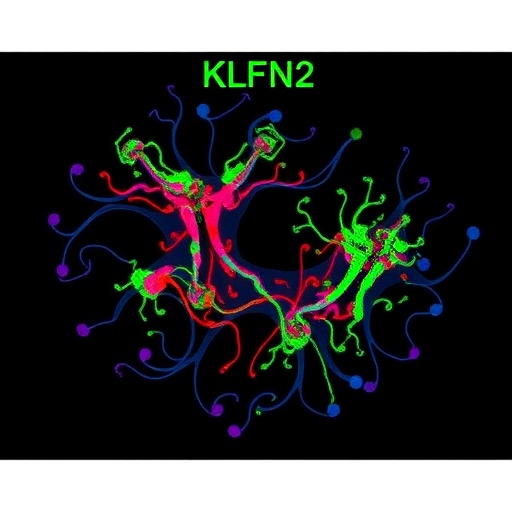The investigation began with a tool known as CRISPR interference, a genetic training program that allowed scientists to pinpoint various proteins impacting MYC production. Ultimately, their focus converged on RBM42, previously overshadowed in the vast network of proteins crucial for cellular functions. The analysis indicated a startling correlation: higher levels of RBM42 were consistently found in cancer patient samples where MYC levels were equally elevated. This correlation was not merely perceptual; it also had serious implications for patient outcomes—those with elevated levels of both proteins tended to exhibit poorer prognoses.
Delving deeper into the molecular machinery of cancer cells, the UCSF team sought to elucidate how RBM42 influences MYC levels. Proteins, including MYC, are synthesized through a two-step process: transcription followed by translation. In transcription, genomic DNA is converted into messenger RNA (mRNA), which then serves as the template for translation. The team discovered that while RBM42 does not block the transcription of MYC mRNA, it plays an essential role in the translation phase, ensuring that the MYC mRNA is effectively utilized by the ribosomes—the cell’s protein factories. When RBM42 was disrupted, MYC production halted, underscoring its role as a critical facilitator of MYC synthesis.
The team’s research revealed that RBM42 actively modifies MYC mRNA, enhancing its suitability for processing by ribosomes. This manipulation allows MYC to be translated efficiently and in significant quantities, effectively favoring its production within the cellular environment. Under normal physiological conditions, both RBM42 and MYC are held in check, yet in cancerous states, RBM42 becomes dysregulated, commandeering ribosomes to manufacture excessive quantities of MYC.
As they shifted their focus from the genetic basis of MYC to the translational machinery that supports its abundance, the researchers began testing their hypotheses in vitro, utilizing pancreatic cancer cell lines. The results were compelling: knocking down RBM42 effectively halted the growth of these cells, creating a ripple effect that stunted the growth of pancreatic tumors in animal models as well. This transformative insight positions RBM42 as a prospective target, potentially allowing for the development of small-molecule inhibitors that could disrupt this process.
The implications of such therapeutic strategies are profound, particularly in light of the aggressive nature of cancers like pancreatic cancer, which present limited treatment options. The traditional focus on direct MYC inhibition often overlooks the underlying regulatory mechanisms that enable its uncontrolled production. By disrupting RBM42 function, researchers propose a novel strategy that could “jam the gears” of cancerous growth and provide a foothold in treating cancers that have thus far proven resistant to other forms of therapy.
This research not only opens new avenues for cancer treatment but also emphasizes the importance of understanding the regulatory pathways governing cancer biology. RBM42’s newfound attention as a cancer ally highlights a paradigm shift in therapeutic approaches, advocating for the need to control how proteins are synthesized rather than solely targeting mutated forms.
As the scientific community races against time to explore these findings, the researchers anticipate that this work will pave the way for clinical applications aimed at breaking the cycle of aggressive tumor growth. The ongoing exploration into the manipulation of RBM42 could eventually lead to breakthroughs that transform how we understand and treat cancer at a molecular level.
By framing cancer treatment within this innovative context, UCSF’s findings signal a burgeoning area of investigative focus, increasingly centered on the cellular machinery that supports rapid and unchecked tumor growth. As these avenues are explored further, patients suffering from some of the most debilitating forms of cancer may one day benefit from advances derived from this new understanding. Overall, this research stands as an important reminder of the complexities of cancer biology and the innovative strategies that may arise from understanding the nuances of protein synthesis pathways.
In conclusion, the work conducted by UCSF researchers not only enriches our understanding of cancer’s molecular underpinnings but also heralds a potential future where targeting translation processes could supplement or even replace traditional approaches to cancer treatment. This shift in perspective could be crucial for addressing the significant challenges posed by formidable cancers, offering hope for a more effective and multifaceted approach to treatment.
Subject of Research: MYC protein synthesis and its regulation by RBM42 in cancer cells
Article Title: UCSF Researchers Uncover Key Mechanism to Halt Tumor Growth in Cancers Driven by MYC Protein
News Publication Date: February 4, 2023
Web References: https://www.ucsf.edu
References: Studies published in Nature Cell Biology
Image Credits: University of California – San Francisco
Keywords: MYC, cancer, RBM42, protein synthesis, pancreatic cancer, tumor growth, translational control, therapeutic strategies, CRISPR, UCSF, cancer research, protein regulation.
Tags: alternative cancer intervention pathwayscancer cell proliferation mechanismscancer growth mechanismsinnovative cancer therapiesMYC protein and cancerovercoming cancer treatment resistancepancreatic cancer treatment strategiesprotein synthesis in cancer cellsregulating MYC protein productiontargeting RBM42 proteintumor aggressiveness factorsUCSF cancer research





